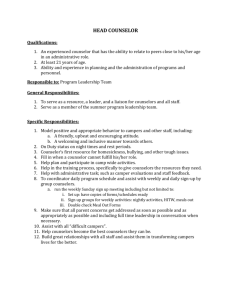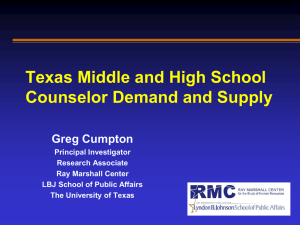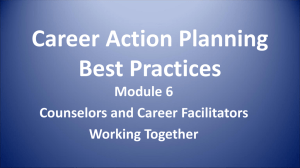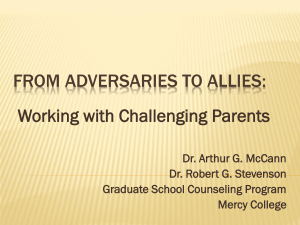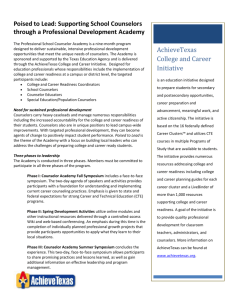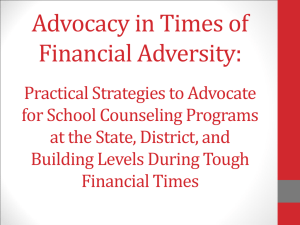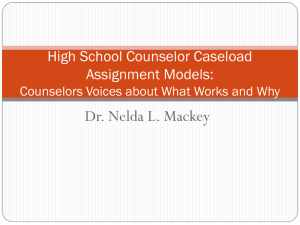Esther Hugo
advertisement
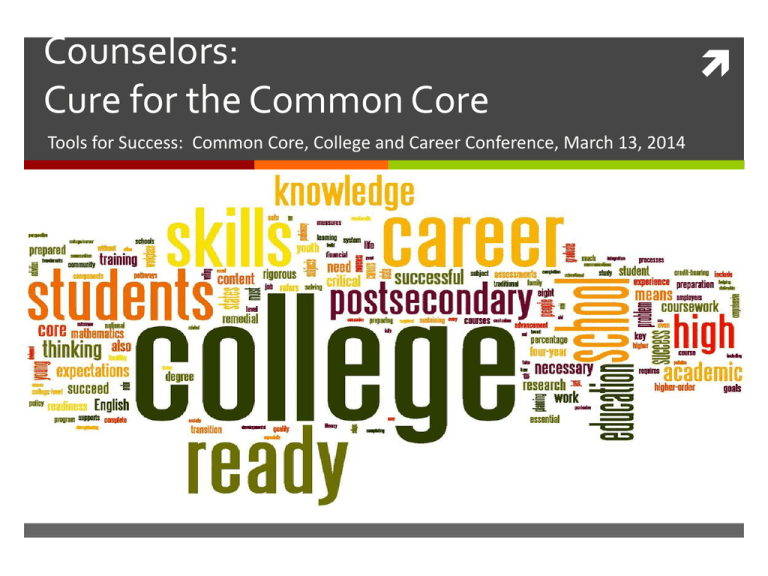
Counselors: Cure for the Common Core Tools for Success: Common Core, College and Career Conference, March 13, 2014 Key Advances of Common Core ENGLISH LANGUAGE ARTS/LITERACY MATHEMATICS Balance of literature and informational texts (non fiction); focus on text complexity Focus, coherence and clarity: emphasis on key topics at each grade level and coherent progression across grades Emphasis on argument, informative/ explanatory writing, and research Balance between procedural fluency and understanding of concepts and skills Literacy standards for history, science and technical subjects Promote rigor through mathematical proficiencies that foster reasoning and understanding across discipline ANCHORED IN COLLEGE AND CAREER READINESS 2 Common Core State Standards Design Focused, coherent, rigorous Internationally benchmarked Evidence and research based Linked to College and Career readiness * * Ready for first-year, credit bearing, postsecondary coursework Common Core State Standards Challenge How do we get from here... Common Core State Standards specify K-12 expectations for college and career readiness ...to here? All students leave high school college and career ready ...and what can Counselors do to help? Common Core Standards : Backward Design Model Started with the End Goal Driving force: Low US college-going rates Economic pressure Race to the Top pushed states to make the choice Common Core Standards Require Counselors to Think across grade levels Develop comprehensive programs Provide academic supports to students Create standards-based college and career focused lessons Local Control Budget Overlaps CC SB 1458 passed in 2012 -Senator Steinberg Test results will constitute no more than 60% of the value of a secondary school Measures graduation rates and college-going rates From API – EQI – Equity Quality Index Counselors as Experts for the Cure Curriculum Assessment College and Career Readiness Data-Driven Practice Counselors and Common Core Curriculum Focus on academic preparation without remediation Quality and level of high school coursework is a key level of curricular reform Counselors experts in transcript evaluation – most important factor in college admission process Counselors as Assessment Experts Formative Assessments allow for Interventions and regular check-ups Checks on student progress and design and provide intervention programs Identify classes/courses/teache rs where students are not successful Counselors in College and Career Readiness http://www.trbimg.com/img -520be020/turbine/la-mecal-freshmen-pictures20130816-008/980 Prepare students for college and career Identify interests linked to major selection Schedule college prep coursework Aspiration building, especially for first-generation students Counselors in College and Career Readiness Provide financial aid information Promote Career Technical Education Assist students through complex application process Facilitate access to college Counselors Demonstrate Data-Driven Practices Analyze and Gather Data on: UC/CSU A-G Completion PSAT, SAT, AP, IB ACT Exams Counselors Demonstrate Data-Driven Practices Analyze Data regarding: Students not on track for college prep Math Students repeating Math courses Review School Policy regarding course selection, offerings, and sequencing Counselors are Collaboration Experts Work with administrators to ensure equity of school-wide policies Schedule and Placement in rigorous classes Remedial Support &Tutoring Identify performance barriers Key Shift – from High School Completion to College Graduation To College and Career Ready! “Closing the gap between high school completion requirements and college entrance expectations is arguably the single most important thing to fix, if we are to address our college completion problem. I feel strongly that higher education must step forward and exercise leadership at this moment in time. A lot is at stake for our nation and well-being of future generations.” -Mike Kirst, President, California State Board of Education Common Core and Higher Education Create a seamless transition between sectors Focus on skills students need to enter college Major issue: Disconnect between K-12 and Higher Ed. AP Program provides curricular coherence Counselors as Leaders and Managers Solution-focused, data driven Counselor a champion and architect of the college-going culture Communicate expectations and requirements Provide strategies for working with students and their families Our Membership has a Role to Play Joint efforts = Strength Identify common issues Increased communication and cross-pollination Focus on Data analysis and training Counselor Accountability Tool Model 1 Baseline Data: 2 Goal Statement: 3 Impact of Levels of Interventions and School Counselor’s Role 4 Individual Level Results/Outcome Statement: Group Level Classroom Level Grade Level School-wide Level 5 Family Level Year-end Data/PPT Community Level Adapted from The College Board’s National Office of School Counselor Advocacy (2010) Identify a Critical Data Point 1 Baseline Data: Number of Latino students enrolled in Algebra 1 Adapted from The College Board’s National Office of School Counselor Advocacy (2010) Goal Statement Components GOAL COMPONENTS 1. Increase/decrease 2. Group that is targeted 2 Goal Statement: (5 parts): Increase enrollment in the Latino students in Algebra I by 50% at the end of registration/ beginning next fall. 3. Target category (e.g. time/class) 4. Degree of change (# or %) 5. End date (month/year) Adapted from The College Board’s National Office of School Counselor Advocacy (2010) Provide Interventions to Ensure Impact 3 Intervention Targets What is in Place? What Could Be? Individual Group Classroom Grade Level School-Wide Family Community Adapted from The College Board’s National Office of School Counselor Advocacy (2010) Analyze Intervention Results Results/Outcome Statement: 4 •Collected data indicates the goal of 50% was not met. •However, several levels of intervention indicate movement toward 50%. •Institutionalization of the successful levels will begin to foster systemic policies/practices. •Revisiting the non-movement levels will occur within 30 days. Adapted from The College Board’s National Office of School Counselor Advocacy (2010) Sharing Outcomes is Key 5 Year-end Strategic Tool Sharing Adapted from The College Board’s National Office of School Counselor Advocacy (2010) Identify Effectiveness and Impact Highlight what’s useful (and what’s not) Develop an Action Plan for Change Troubling Data/Baseline data/Special Issue Link with Common Core and Local Accountability Plan– Principal’s Goals Form a Team Action steps – with a timeline Results Next steps Result Shared with and Lessons Learned First Steps in Developing the Plan • Involve Administration • Develop Collaborative Teams - Inside - Outside • Deal with Resistance - Anticipate - Who would benefit Assemble Your Team Practitioners Leaders Faculty Community members Parents School Board members Maintain Your Momentum: Strategies • Developing Strategies - Team meetings - Shared responsibilities - Goal setting • Evaluating Progress - Use the data - Consider short and long-term approaches • Celebrating and Sustaining - Presentations Sustainability: Essential Questions - How can we collaborate with colleagues? - Do we have the Will to Change? - Who sets the Priorities? - Who Keeps us on Track? - When do we “check in”? - How do we communicate our success? Be Bold in Sharing Your Work Faculty Meetings Administrator Meetings School Board Meetings PTSA Meetings District Headquarters Presentation Outline Demographics background Data overview Troubling data Align troubling data with Common Core and Local Accountability Plan Intervention summary Post-intervention results Pre-Post comparison Lessons learned and Next Steps Keep in Mind for your Common Core Plan • Every school has existing resources • Build partnerships! • You are not alone! • Intentionally link to Common Core and LCFF • Think BIG, but remember the details.
